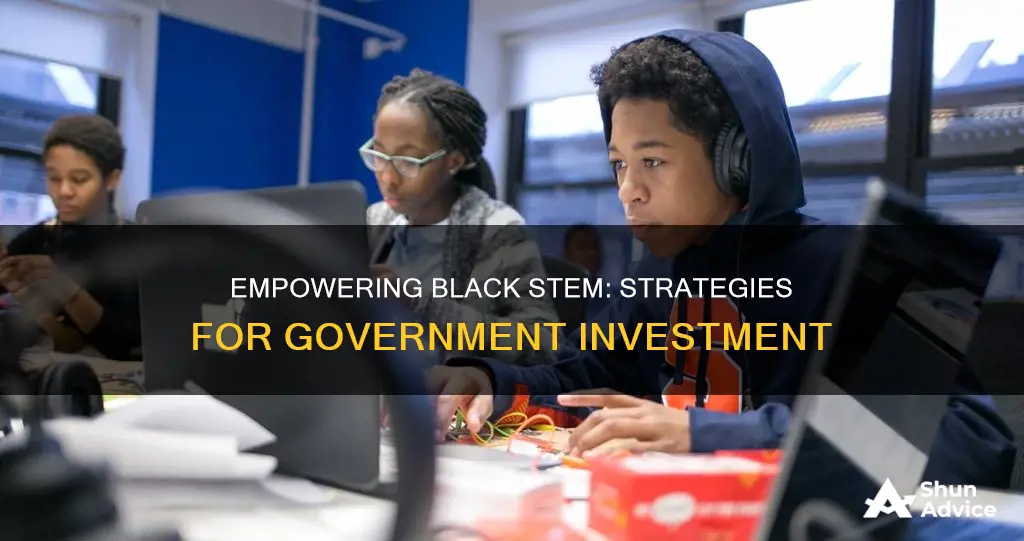
The underrepresentation of Black people in STEM is a result of systemic racism and a lack of government investment in Black communities. Despite Black Americans making up 14.2% of the US population, Black-owned businesses make up only 2.2% of the nation's employer businesses. This is due to a multitude of factors, including the racial wealth gap, lack of access to investment capital, and discriminatory policies. To address this issue, the government should invest in STEM education and support for Black students and scientists, provide grants and funding for diversity and inclusion initiatives, and address the structural barriers that hinder Black entrepreneurship and wealth accumulation.
What You'll Learn

Provide funding for HBCUs to strengthen STEM undergraduate education and research
The Historically Black Colleges and Universities Undergraduate Program (HBCU-UP) was established in 2000 by the National Science Foundation (NSF) to assist HBCUs in strengthening their STEM education and research capacity. HBCU-UP provides awards to develop, implement, and study innovative models and approaches to enhance the preparation and success of underrepresented minority students in STEM graduate programs and the workforce.
HBCU-UP offers various funding opportunities, including:
- Implementation Projects (including Achieving Competitive Excellence), which support the design, implementation, study, and assessment of comprehensive institutional efforts to increase the number of students receiving undergraduate STEM degrees and enhance their preparation.
- Broadening Participation Research Projects, which support research on creating and studying new theory-driven models and innovations related to the participation and success of underrepresented groups, especially African Americans, in STEM undergraduate education.
- Targeted Infusion Projects, which provide support for short-term, well-defined goals to enhance and innovate undergraduate STEM education at HBCUs.
- Planning Grants, which support activities that will lead to future submissions, such as the development of collaborative networks and exploration of innovative approaches to address research capacity needs.
- Research Initiation Awards, which provide funding for STEM faculty with no prior or recent research funding to pursue research at their home institution, another research-intensive institution, an NSF-funded research center, or a national laboratory.
The NSF also offers supplemental funding for existing awardees to broaden participation in STEM and encourages new proposals and supplemental funding requests for HBCU-UP.
In addition to HBCU-UP, the NSF has other initiatives to support HBCUs in strengthening STEM undergraduate education and research:
- The Historically Black Colleges and Universities - Excellence in Research (HBCU-EiR) initiative supports research at public and private HBCUs to strengthen their research capacity and promote engagement with the NSF.
- The Centers of Research Excellence in Science and Technology HBCU Research Infrastructure for Science and Engineering (CREST-RISE) initiative supports the expansion of research and education capabilities of minority-serving institutions to strengthen their science and engineering graduate programs and successfully produce research doctoral students.
- The Louis Stokes Alliances for Minority Participation (LSAMP) initiative supports university alliances and post-baccalaureate fellowship programs focused on increasing the number of STEM bachelor's and graduate degrees awarded to populations historically underrepresented in STEM fields.
- The NSF also offers fellowships for undergraduate and graduate students, providing funding and opportunities to gain research experience and skills in STEM fields.
The Future of Investment Management: 2030 Vision
You may want to see also

Support Black entrepreneurs in high-growth industries
Supporting Black entrepreneurs in high-growth industries is a crucial step towards achieving economic inclusion and addressing systemic racism. Here are some strategies to support Black entrepreneurs in these sectors:
- Targeted investments: Black entrepreneurs in high-growth industries such as wholesale trade, manufacturing, and utilities require targeted investments. These sectors demand substantial startup capital, which cannot be easily supported by home equity or individual wealth. By investing in Black entrepreneurs in these industries, there can be an overall community development, creating more jobs and infusing capital into Black communities.
- Address systemic barriers: Black business owners face economic, market, sociocultural, and institutional barriers rooted in racial discrimination. These include limited access to capital, expertise, and business networks. Addressing these barriers may involve policies that ensure equitable opportunities and outcomes, such as enforcing anti-discrimination laws and creating internal and external watchdog groups.
- Equitable access to capital: Black-owned small and medium-sized businesses (SMBs) need direct investment, grants, loans, and revenue-participation agreements. This is especially critical during economic crises like the COVID-19 pandemic, which disproportionately affected Black-owned businesses. Increasing the availability of financial resources, such as start-up and expansion capital, will be crucial for improving Black entrepreneurs' access to capital.
- Business capabilities and knowledge sharing: Black-owned SMBs can benefit from support in building capabilities and knowledge sharing. This may include reskilling and upskilling workers, providing resources to identify new market opportunities, and offering free technology services and managerial assistance to help with digital transformation.
- Expand mentorship and sponsorship opportunities: Representation and participation in mentorship and sponsorship programs can help Black entrepreneurs overcome sociocultural barriers. The private sector should take the lead by building more inclusive teams and developing more Black leaders. Community programs can also facilitate connections between established businesses and compatible Black-owned start-ups.
- Public-private partnerships: Public-private partnerships are vital to supporting Black-owned businesses. The federal government, in particular, has a role in building the capacity of lending institutions that serve disenfranchised Black business owners.
- Place-based investments: The devaluation of housing and businesses in Black neighborhoods calls for incentives for consumer-facing firms and high-growth businesses to operate in these areas. This can help address the concentration of economic activity in large metropolitan areas and promote investment in Black communities.
- Homeownership: Most people start businesses using personal wealth, often from home equity. Addressing the devaluation of homes in Black neighborhoods and increasing homeownership rates can provide Black entrepreneurs with the necessary capital to start and grow their businesses.
- Procurement practices: Governments and corporations can set goals to increase the number of Black-owned businesses qualifying for contracts. They can adopt more inclusive procurement processes and dedicate funds to supplier development programs, making it easier for Black-owned suppliers to participate in supply chains.
- Support organizations: Black entrepreneurs can benefit from support organizations like the Black Business Alliance, Black Business Association, Black-Owned Business Resource Center, Black Connect, Black Enterprise, Black Founders, and Elevate Together. These organizations provide various resources such as funding, mentorship, networking, and business development opportunities.
By implementing these strategies, we can work towards a more inclusive economy that provides Black entrepreneurs with the support and opportunities they need to succeed in high-growth industries.
Building a Diversified Investment Portfolio: Strategies for Success
You may want to see also

Address housing market discrimination
Addressing Housing Market Discrimination
Housing market discrimination is a critical issue that disproportionately affects Black communities and hinders their economic advancement. Here are some strategies to address this issue:
Increase Homeownership Opportunities for Black Communities
Homeownership is often viewed as a gateway to the American dream and intergenerational wealth building, but Black Americans face significant barriers in becoming homeowners due to historical and systemic racism. To address this, governments should:
- Implement policies to increase support for small-dollar mortgage loan programs, making homeownership more accessible to Black borrowers.
- Address the uneven costs of mortgages for Black homeowners by creating refinancing options to reduce monthly costs and lower barriers to entry.
- Provide credit and down payment assistance to borrowers impacted by discriminatory housing and lending practices, such as redlining and restrictive covenants.
- Encourage diversification in the appraisal profession to mitigate bias and ensure fair valuations for Black-owned properties.
- Advocate for policies that promote integration and equitable investment in communities of color, counteracting the historical underinvestment in these areas.
Enhance Access to Credit and Lending
Black individuals and businesses often face challenges in accessing credit and loans due to discriminatory lending practices and a lack of banking options in their communities. To address this, governments can:
- Promote equal access to lending opportunities by enforcing anti-discrimination laws and holding financial institutions accountable for unfair practices.
- Encourage the establishment of community development financial institutions (CDFIs) that provide lending and technical assistance to underserved communities, helping to create jobs and stimulate economic growth.
- Support initiatives that offer alternative funding options, such as grants, fellowships, and investment opportunities specifically for Black-owned businesses.
Strengthen Fair Housing Enforcement
Despite the existence of fair housing laws, discrimination in the housing market persists. To address this, governments should:
- Reinstate and strengthen the Affirmatively Furthering Fair Housing (AFFH) rule, making local jurisdictions responsible for planning and taking active steps to achieve fair housing.
- Empower federal, state, and local governments, as well as nonprofits, to enforce the Fair Housing Act by providing additional funding and resources for investigations and compliance monitoring.
- Address systematic discrimination in the housing market by firmly enforcing the Fair Housing Act's disparate impact rule, holding housing agencies and players accountable for discriminatory actions.
Promote Equitable Neighborhood Development
The historical underinvestment in Black neighborhoods has led to a lack of resources, including access to quality education, well-funded schools, and green spaces. To address this, governments can:
- Increase funding for schools in majority-Black communities to bridge the funding gap and ensure that all students have equal opportunities for a quality education.
- Invest in infrastructure and community development projects that benefit historically underserved neighborhoods, such as improvements to transportation, healthcare, and public spaces.
- Encourage mixed-income housing developments and provide incentives for integrated neighborhoods to promote socioeconomic diversity and help break the cycle of segregation.
By implementing these strategies, governments can help address housing market discrimination and promote economic advancement for Black communities.
Smart Investing Guide: 40 Lakh Strategies for Indians
You may want to see also

Increase funding for public education
Overview
Public education funding in the US relies primarily on state and local resources, with a small share of total revenues allotted by the federal government. Districts in high-poverty areas, which serve larger shares of students of colour, get less funding per student than districts in low-poverty areas, which predominantly serve white students. This highlights the system's inequity.
Suggested solutions
- A Bigger Slice: Commit more of the existing state budget to education, cutting elsewhere.
- A Bigger Pie: Raise more taxes at the state level to provide more money for education.
- A Different Pie: Allow local taxes to provide new money for education.
- Actual Pie: Hold bake sales and other local fundraisers.
A Bigger Slice
The federal government has a responsibility to increase its role and establish a robust, stable, and consistent school funding plan that channels sufficient additional resources to less affluent students in good times and bad. Spending on public education should be retooled as an economic stabilizer, with increases automatically kicking in during recessions.
A Bigger Pie
The federal government could increase taxes at the state level. For example, in 2012, California voters passed Proposition 30, which raised taxes on the state's wealthiest earners. In 2016, voters overwhelmingly extended the tax to 2030 (Prop 55).
A Different Pie
Allowing local taxes to provide new money for education could be a solution. However, this is very difficult under California's Proposition 13, which requires that local governments, including school districts, must get a 2/3 voter approval to pass special taxes.
Actual Pie
Local fundraising for schools, such as bake sales, is another option, but it is not a sustainable solution and cannot match the funding power of a tax.
Equities Investment: Strategies for Beginners to Start
You may want to see also

Advocate for more Black representation in government
Black communities across the United States continue to be overlooked and pushed out, emphasizing the need to fight for change that will bring about true power and freedom for Black families in America. Despite comprising approximately 14.2% of the U.S. population, Black businesses account for only 2.2% of the nation's employer businesses. This underrepresentation of Black businesses is costing the U.S. economy millions of jobs and billions of dollars in unrealized revenues.
To address this disparity, it is crucial to advocate for increased Black representation in government, as it will enable greater participation in policy-making and resource allocation decisions that impact Black communities. Here are some strategies to achieve this:
- Electoral Politics: Encourage and support Black individuals to run for political office at the local, state, and federal levels. Provide resources, training, and mentorship to help them navigate the political landscape effectively.
- Community Organizing: Mobilize Black communities to engage in the political process actively. This includes registering to vote, participating in elections, and advocating for issues that affect their lives. Community organizations can play a pivotal role in educating and empowering community members to make informed decisions.
- Coalition Building: Collaborate with diverse communities and form coalitions to advocate for shared goals. By uniting with other marginalized groups, Black communities can amplify their voices and build a stronger front for change.
- Leadership Development: Invest in leadership development programs that empower Black individuals to become effective leaders and representatives. This includes providing opportunities for skill-building, networking, and mentorship to help them navigate the path to political office successfully.
- Policy Advocacy: Advocate for policies that promote racial equity and social justice. This includes pushing for campaign finance reforms, equitable education, economic opportunities, and an end to systemic racism in all its forms.
- Accountability: Hold elected officials accountable for their actions and ensure they fulfill their promises to Black communities. This can be achieved through consistent political participation, community organizing, and strategic advocacy campaigns.
By implementing these strategies, we can work towards increasing Black representation in government, which will ultimately lead to more effective advocacy for investments in STEM in Black communities.
Investing Abroad: A Guide for Indians
You may want to see also
Frequently asked questions
Investing in STEM in Black communities helps to address systemic racism and provides economic opportunities for Black people. It also helps to close the racial wealth gap and creates a diverse and skilled workforce for the future.
Governments can provide grants, funding, and resources to individuals, institutions, and organizations that promote diversity and inclusion in STEM fields. They can also support alliances among universities and colleges to increase the number of Black scientists and students in STEM fields.
Governments can provide investment and products, such as loans and grants, to Black-owned businesses and entrepreneurs. They can also address systemic barriers, such as discriminatory lending practices and a lack of access to capital, that hinder the growth and development of Black businesses.
The National Science Foundation in the United States provides support and resources for Black students and scientists in STEM fields. They offer grants, fellowships, and awards to promote diversity and inclusion. Historically Black Colleges and Universities (HBCUs) also play a crucial role in strengthening STEM education and research in Black communities.
Individuals can advocate for policy changes and increased funding for initiatives that support STEM education and careers for Black people. They can also support and amplify the voices of Black leaders and organizations working in this space.







